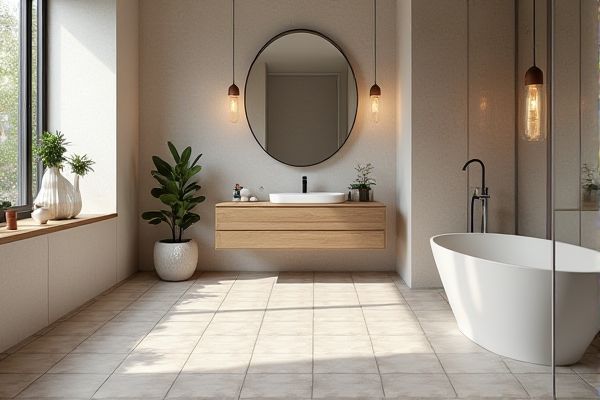
Large tiles create a sleek, modern look by minimizing grout lines and making spaces appear more expansive, while small tiles offer versatile design options with intricate patterns and better slip resistance. Discover the advantages and best applications of each tile size to find the perfect fit for your space.
Table of Comparison
| Aspect | Large Tiles | Small Tiles |
|---|---|---|
| Installation Time | Faster due to fewer grout lines | Longer because of more grout lines and pieces |
| Visual Impact | Modern and spacious look | Intricate patterns and detailed aesthetics |
| Maintenance | Easier cleaning with fewer grout lines | More grout lines require frequent cleaning |
| Durability | Better for uneven surfaces due to larger surface area | Can flex more, suitable for curved surfaces |
| Cost | Generally more expensive per piece | Typically lower per piece but labor costs can be higher |
| Design Flexibility | Less flexibility for complex patterns | Highly flexible to create complex designs |
Introduction to Tile Sizes in Interior Design
Large tiles create a spacious and seamless look by minimizing grout lines, making them ideal for modern and open-concept interiors. Small tiles offer intricate patterns and texture options, enhancing visual interest and flexibility for unique design elements. Choosing tile size depends on room scale, style preference, and desired ambiance, balancing aesthetics with functionality.
Large Tiles vs Small Tiles: An Overview
Large tiles create a spacious, seamless look with fewer grout lines, making your floors easier to clean and ideal for open areas. Small tiles offer greater design flexibility, intricate patterns, and better slip resistance, which works well in bathrooms and smaller spaces. Choosing between large tiles and small tiles depends on your room size, style preference, and maintenance needs.
Aesthetic Impact: Creating Visual Space
Large tiles create an expansive, seamless surface that enhances the perception of spaciousness by minimizing grout lines and visual interruptions. Small tiles, with their numerous grout joints, introduce texture and pattern but can make a space feel busier and more segmented. Your choice between large and small tiles significantly influences the aesthetic impact, affecting how open and airy your room appears.
Installation Complexity and Cost
Large tiles typically offer faster installation due to fewer grout lines and reduced labor time, lowering overall costs despite higher per-tile prices. Small tiles often require meticulous alignment and more grout, increasing installation complexity and labor expenses. Your choice affects budget and time, as large tiles simplify the process while small tiles demand precision and additional resources.
Grout Lines: Maintenance and Cleaning
Large tiles feature fewer grout lines, reducing the areas where dirt and grime can accumulate, making maintenance and cleaning easier and quicker. Small tiles create more grout lines, which are prone to staining and require more frequent scrubbing and sealing to keep your surfaces looking fresh. Choosing large tiles minimizes grout upkeep, saving you time and effort in regular cleaning routines.
Tile Suitability for Different Room Sizes
Large tiles create a sense of spaciousness and are ideal for open, expansive rooms, minimizing grout lines and enhancing a seamless look. Small tiles work better in compact or irregularly shaped spaces, offering greater flexibility for intricate layouts and slip resistance. Your choice should consider room dimensions and design goals to achieve the perfect balance of aesthetics and functionality.
Durability and Material Options
Large tiles often provide enhanced durability due to fewer grout lines, reducing weak points prone to cracking and wear, making them ideal for high-traffic areas. Materials commonly available in large formats include porcelain, natural stone, and ceramic, each offering strong resistance to moisture and physical impact. Small tiles, typically made from ceramic, glass, or mosaic materials, may require more maintenance because of numerous grout lines but allow for intricate patterns and flexibility in design.
Design Flexibility and Style Choices
Large tiles offer expansive surface coverage that enhances minimalist and modern design aesthetics while creating the illusion of spaciousness in rooms. Small tiles provide intricate patterns and greater versatility, allowing for customized mosaics, detailed borders, and textured effects that complement traditional or eclectic styles. Choosing between large and small tiles mainly depends on the desired visual impact and design complexity of the space.
Resale Value and Market Trends
Large tiles are increasingly favored in modern home design, boosting your property's resale value by creating sleek, spacious visuals that appeal to contemporary buyers. Market trends show a growing preference for minimal grout lines and seamless flooring, which large tiles provide, enhancing both aesthetics and maintenance. Small tiles, while versatile, may appear dated and can suggest higher renovation costs due to more grout upkeep, potentially impacting your home's marketability.
Choosing the Right Tile Size: Key Considerations
Large tiles create a sleek, modern look with fewer grout lines, making your space appear larger and easier to clean, while small tiles offer intricate patterns and better traction in wet areas. Consider the room size, layout complexity, and maintenance needs when selecting tile size, as large tiles work best in spacious, open areas and small tiles suit detailed designs or uneven surfaces. Your choice should balance aesthetics, functionality, and installation cost to achieve optimal visual impact and durability.
 homyna.com
homyna.com